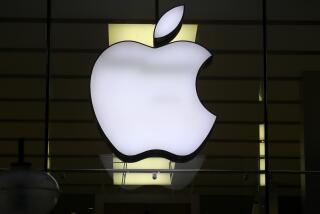IPod seekers become Macintosh believers
- Share via
SAN FRANCISCO — The more buzz Apple Inc. builds for its gadgets, the more computers it sells.
The company known until January as Apple Computer said Monday that it moved more Macintoshes during its just-ended quarter than ever before. The surge went counter to industry trends because Apple plans to release its fancy Leopard operating system Friday, and buyers normally wait rather than snap up new computers just before an upgrade.
A surge in iPods and iPhones also helped boost Apple’s revenue by 28% to $6.2 billion, and its profit by 67% to $904 million. The strong results in the fiscal fourth quarter showed the power of the so-called halo effect: People enter Apple’s stores to gaze at the new portable devices, but many leave with Macs, analysts said.
“The halo effect is real,” said Gene Munster, senior research analyst with Piper Jaffray. “You used to have to explain why you bought a Mac two years ago. Soon you’ll have to explain yourself for not buying one.”
The question is whether the halo effect will push the mass consumer to view the Macintosh, once a fringe computer for a select few, as a viable alternative to Windows-based computers. Apple’s computer market share reached 6.3% in the third quarter, up from 5.7% a year before, according to research firm IDC.
For its fiscal fourth quarter, which ended Sept. 29, Apple posted a profit of $1.01 a share, beating Wall Street’s consensus estimate of 86 cents.
Apple’s shares gained $3.94, or 2.3%, reaching a new high of $174.36, then jumped a further 6.9% to $186.35 in extended trading after the earnings report.
With Leopard going on sale Friday, Apple is poised to increase the Mac’s appeal. For $129, the upgrade to the Mac’s OS X operating system makes desktop programs easier to find through such features as Time Machine, which allows users to flip through old versions of the same document.
Sales of Windows-based PCs usually go dormant in the quarter before Microsoft Corp. ships a new operating system, as when it started selling Vista last fall. But analysts said Macintosh sales typically bucked that pattern.
The company, based in Cupertino, Calif., said it sold 1.1 million iPhones during the quarter, bringing the total to nearly 1.4 million. It plans to begin selling the phone in Europe next month.
In a call with analysts, Apple Chief Operating Officer Timothy Cook said the company guessed that about 250,000, or about 18%, of the iPhones were bought with the intention of using them without cellphone service from Apple’s wireless partner, AT&T; Inc. The iPhone, which went on sale at the end of June, is a combination cellphone, iPod and Internet browsing device.
And Apple should know -- its bottom line is tied to AT&T;’s success. The firm reported that $118 million of its quarterly revenue came from the iPhone, iPhone accessories and what AT&T; pays Apple monthly for each AT&T; service subscriber. The company will spread out revenue from iPhone sales over 24 months.
Munster said he estimated that the firm received $15 to $18 monthly from AT&T; for each iPhone owner. “Apple wins either way,” he said.
Although the iPhone has been marketed mostly to individuals, Cook indicated that the gadget could begin selling more to small and medium-size businesses.
“If they penetrate the small-business market with the iPhone, then you can expect them to start selling Macs there too,” said Andy Hargreaves, an analyst at Pacific Crest Securities.
Apple also said it moved 10 million iPods, a 17% increase. But its iPod revenue rose only 4%, showing that discounted prices cut into profit.
Apple did not report directly on sales of Apple TV, a device that allows shows and movies downloaded from its iTunes store to be shown on a TV.
“For the company to have a stronghold on digital media, they need to be in the living room,” said Darren Aftahi, a stock research analyst with ThinkEquity Partners. “That’s the one piece that’s a key to solidifying Apple buyers for the long term.”
The biggest issue for Apple may be managing expectations, including those of investors. Its stock is up 105% in 2007.
“This year, they were able to beat people’s expectations,” Hargreaves said. “It’s going to be difficult to outperform those numbers next year.”
--






